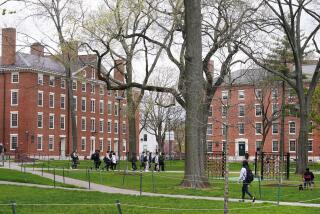College-Bound Latinos Bloom in Big High Schools, Study Shows
- Share via
Smaller schools are not necessarily better--at least not for Latino high school students aiming for college, according to a national study on college admission exam scores released Monday in Anaheim.
Despite a popular belief that small schools provide better education, Prof. George A. Chambers of the University of Iowa said his national study of Latino students shows that college-entrance test scores are considerably higher among graduates of large high schools. The ACT (American College Testing) scores are higher for both Latino and Anglo students at big-enrollment high schools, he said.
“While many believe that big is bad, it looks as if big is better,” Chambers told a session of the National Assn. of Secondary School Principals meeting at the Anaheim Convention Center.
Chambers’ work analyzed college-entrance test scores of Latinos around the nation. He said the study indicated that Latino students benefit from large schools because of the many special teachers available, such as in science and math.
A corollary finding of his study was that Latino students score much higher on the ACT tests if they have had several advanced courses, such as trigonometry, chemistry and calculus. Larger high schools usually have more advanced courses than do smaller schools. Thus, according to the study, Latinos at large high schools have more opportunities to take advanced courses, thereby improving their chances for college entrance.
The study also found that Latinos do no better at Catholic schools than at public schools, when all other factors are considered.
Chambers, who is with the University of Iowa’s division of educational administration, said it was not fully clear why bigger high schools are more likely to produce students with better college aptitude.
“I cannot say with certainty, but I can speculate,” he said. “The larger the school, the greater the chance for departmentalization, with a department head (such as for math, science and other academic subjects).”
Chambers’ study involved analysis of the ACT scores of Latino and Anglo high school students “who were similarly situated with regard to the same high school attended, same family income range, same mathematics courses taken, same science courses taken, same gender and same number of siblings.”
Not surprisingly, his study found that the higher the family income, the better high school students performed on the college-entrance tests. Numerous other academic studies have found a direct correlation between income and academic achievement.
But the finding that big high schools were producing “much better” college applicants than smaller schools jolted long-held popular beliefs, Chambers noted. “As the size of a high school graduating class increases, so do composite mean test scores of both Hispanic and Caucasian students,” he said. A chart accompanying his study showed that composite ACT scores of Latino students rose with the size of high school attended.
During a press conference, Chambers was asked if his findings suggest that parents should seek to put their children in larger high schools, if they have the opportunity. “Not necessarily,” he responded. “Each situation will differ. I’m not trying to dodge the question, but it all depends upon that specific school. If we could give them a choice of maybe a hundred schools and say here is a choice of 100 larger and 100 smaller schools, then you could say, ‘You’d be better off going to the 100 larger schools.’ ”
Other conclusions in Chambers’ study:
- There is “no statistical difference . . . in mean composite (ACT test) scores between (Latinos) in public and those in Catholic schools when their family income level was the same.”
- “ . . . (Latino) test scores were positively associated with (high school) courses taken, and in particular with trigonometry, calculus, algebra II and chemistry.
- “When (Latinos) become better situated (such as in family income), their test scores increase more than (Anglos).”
- “ . . . A substantially higher percentage of Puerto Rican/Cuban students have taken advanced (high school) course work than Mexican-American/Chicano students. . . . The reason for differences in course work taken may result from differences in income levels and from differences in expectations on the part of the students, their peers, parents, etc.”
More to Read
Sign up for Essential California
The most important California stories and recommendations in your inbox every morning.
You may occasionally receive promotional content from the Los Angeles Times.










